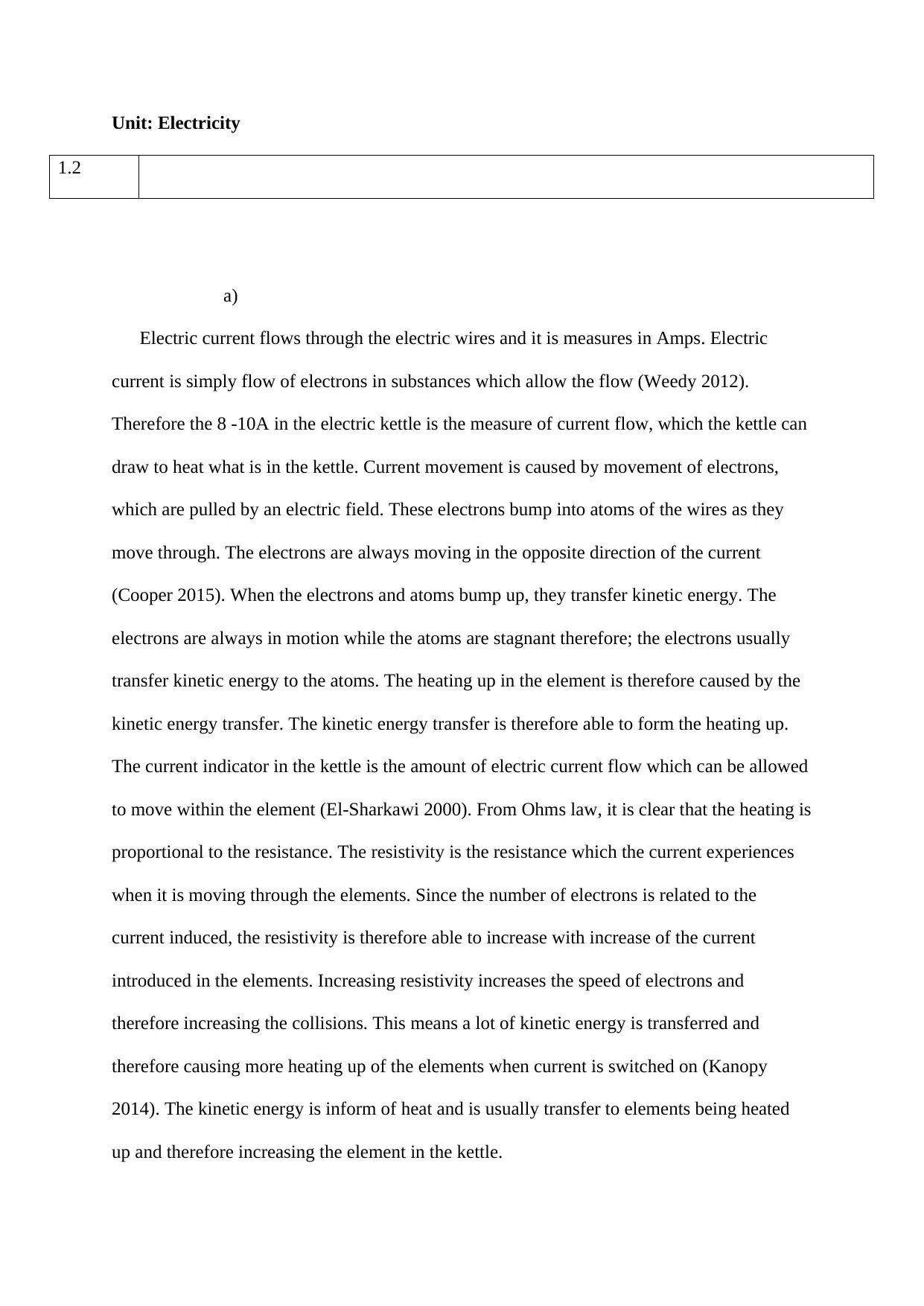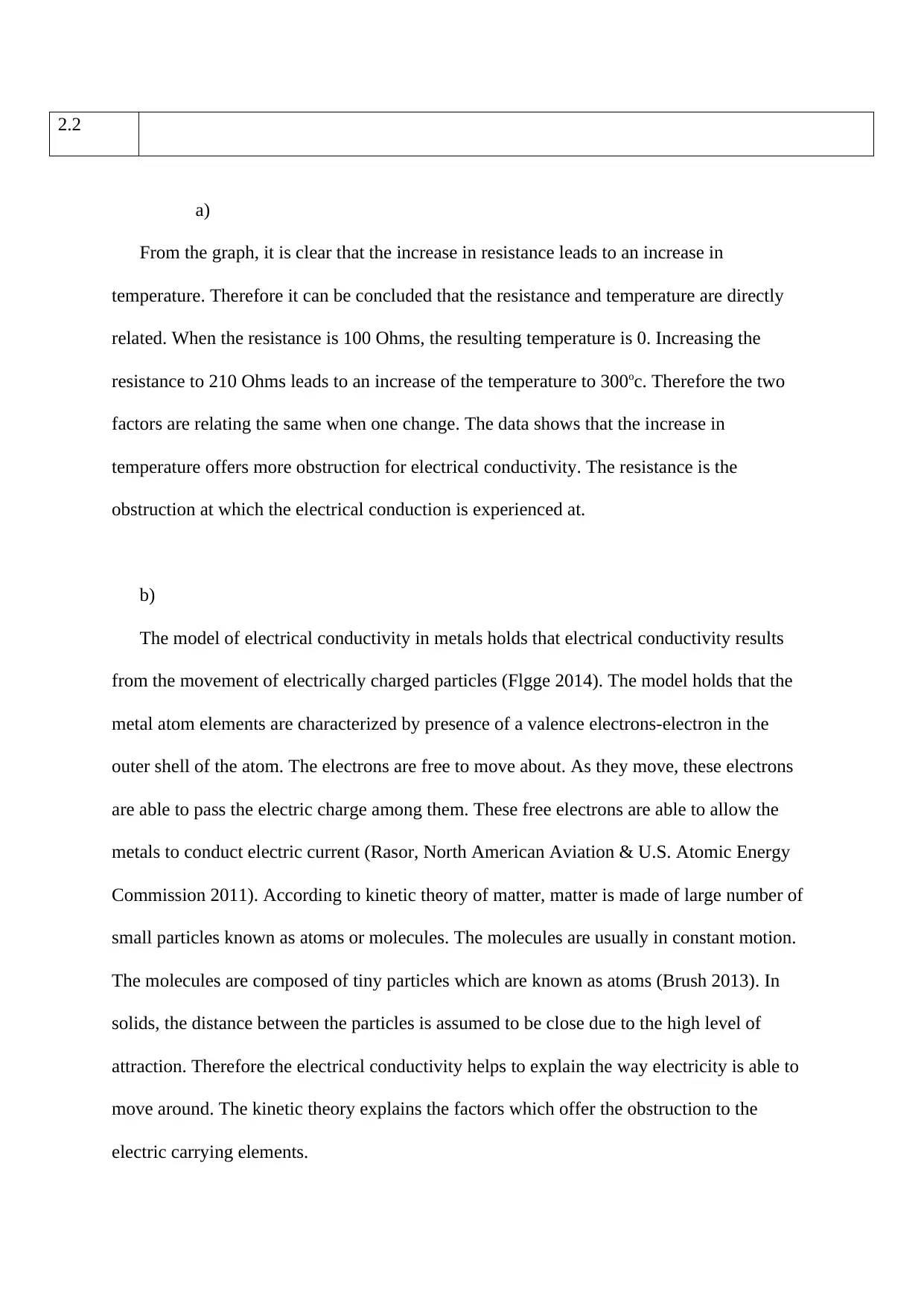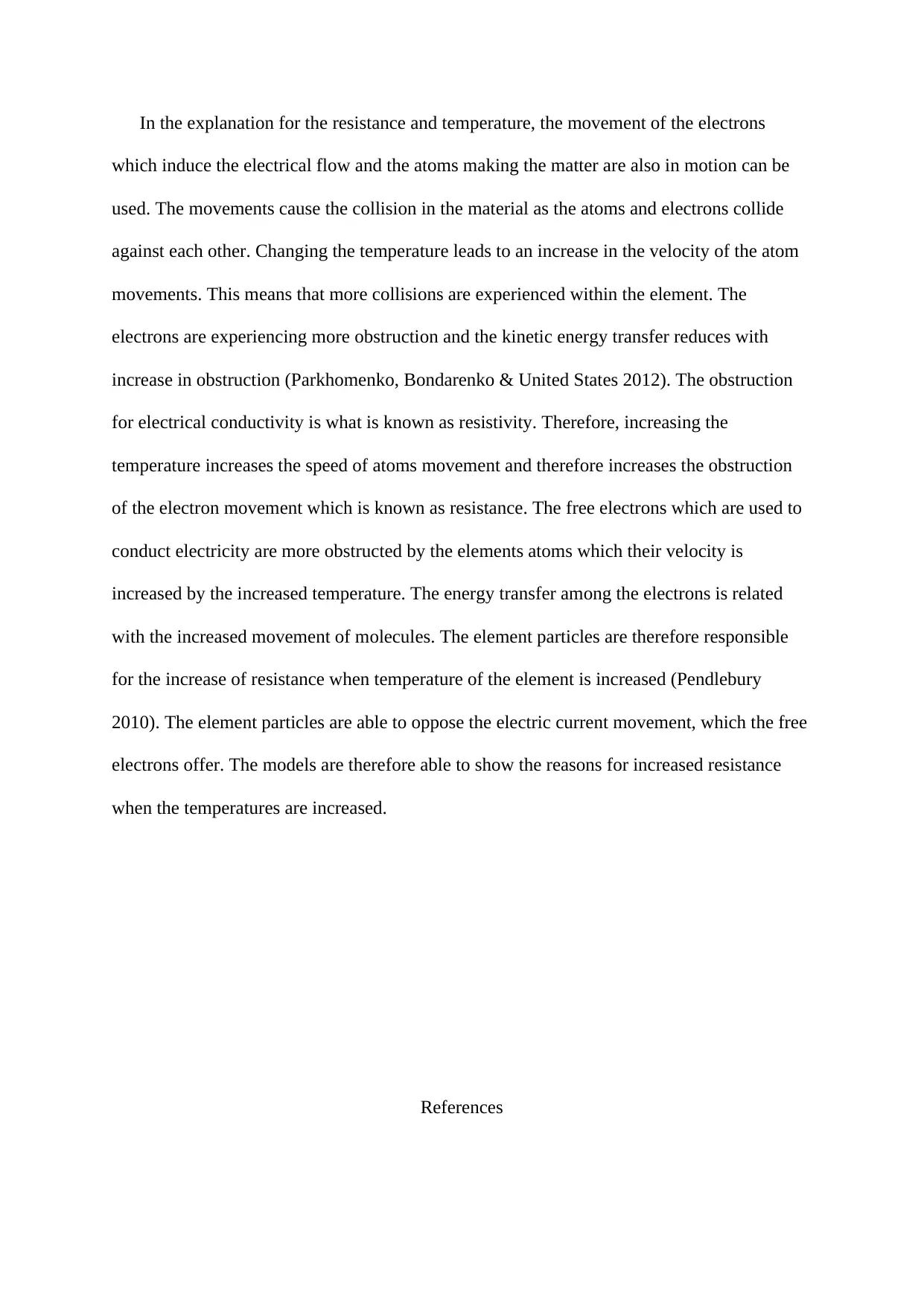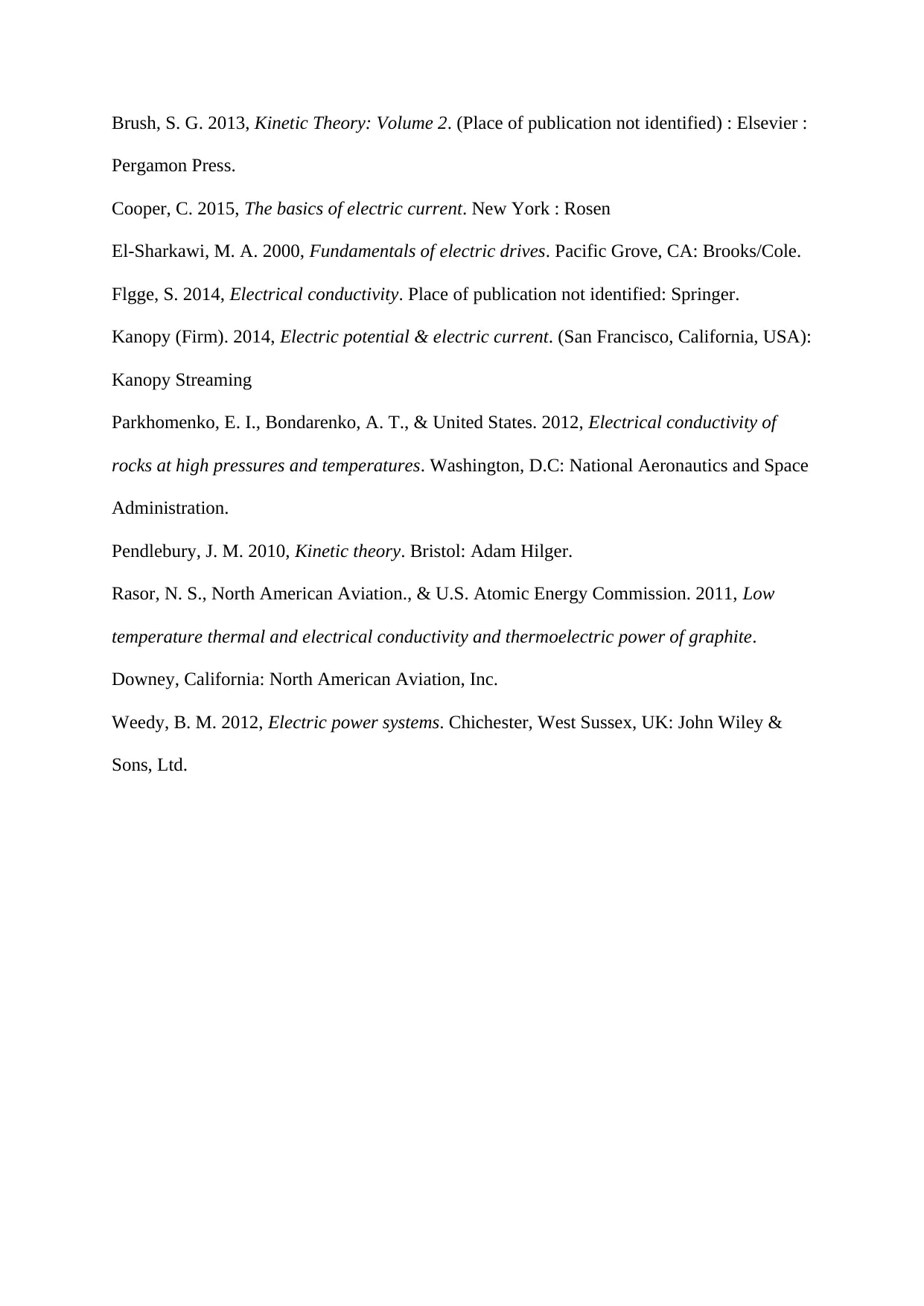Physics Assignment: Electric Current, Resistance, and Heat Transfer
VerifiedAdded on 2020/05/28
|5
|1094
|68
Homework Assignment
AI Summary
This assignment explores the principles of electric current, resistance, and their relationship with temperature. The student analyzes how electric current flows through wires, measured in Amps, and its connection to the movement of electrons. It explains how the kinetic energy transfer from electrons colliding with atoms causes heating in elements like an electric kettle. The assignment references Ohm's law and resistivity to explain how resistance increases with current, leading to increased heating. The analysis further examines the direct relationship between resistance and temperature, explaining that increased resistance obstructs electrical conductivity, as described by the model of electrical conductivity in metals and kinetic theory of matter. The document also explains how increased temperature leads to increased obstruction of electron movement, and thus increased resistance, as the atoms move faster, causing more collisions and reducing kinetic energy transfer. The document concludes by referencing several sources to support the analysis.

Name:
Course:
Professor:
Date:
Course:
Professor:
Date:
Paraphrase This Document
Need a fresh take? Get an instant paraphrase of this document with our AI Paraphraser

Unit: Electricity
1.2
a)
Electric current flows through the electric wires and it is measures in Amps. Electric
current is simply flow of electrons in substances which allow the flow (Weedy 2012).
Therefore the 8 -10A in the electric kettle is the measure of current flow, which the kettle can
draw to heat what is in the kettle. Current movement is caused by movement of electrons,
which are pulled by an electric field. These electrons bump into atoms of the wires as they
move through. The electrons are always moving in the opposite direction of the current
(Cooper 2015). When the electrons and atoms bump up, they transfer kinetic energy. The
electrons are always in motion while the atoms are stagnant therefore; the electrons usually
transfer kinetic energy to the atoms. The heating up in the element is therefore caused by the
kinetic energy transfer. The kinetic energy transfer is therefore able to form the heating up.
The current indicator in the kettle is the amount of electric current flow which can be allowed
to move within the element (El-Sharkawi 2000). From Ohms law, it is clear that the heating is
proportional to the resistance. The resistivity is the resistance which the current experiences
when it is moving through the elements. Since the number of electrons is related to the
current induced, the resistivity is therefore able to increase with increase of the current
introduced in the elements. Increasing resistivity increases the speed of electrons and
therefore increasing the collisions. This means a lot of kinetic energy is transferred and
therefore causing more heating up of the elements when current is switched on (Kanopy
2014). The kinetic energy is inform of heat and is usually transfer to elements being heated
up and therefore increasing the element in the kettle.
1.2
a)
Electric current flows through the electric wires and it is measures in Amps. Electric
current is simply flow of electrons in substances which allow the flow (Weedy 2012).
Therefore the 8 -10A in the electric kettle is the measure of current flow, which the kettle can
draw to heat what is in the kettle. Current movement is caused by movement of electrons,
which are pulled by an electric field. These electrons bump into atoms of the wires as they
move through. The electrons are always moving in the opposite direction of the current
(Cooper 2015). When the electrons and atoms bump up, they transfer kinetic energy. The
electrons are always in motion while the atoms are stagnant therefore; the electrons usually
transfer kinetic energy to the atoms. The heating up in the element is therefore caused by the
kinetic energy transfer. The kinetic energy transfer is therefore able to form the heating up.
The current indicator in the kettle is the amount of electric current flow which can be allowed
to move within the element (El-Sharkawi 2000). From Ohms law, it is clear that the heating is
proportional to the resistance. The resistivity is the resistance which the current experiences
when it is moving through the elements. Since the number of electrons is related to the
current induced, the resistivity is therefore able to increase with increase of the current
introduced in the elements. Increasing resistivity increases the speed of electrons and
therefore increasing the collisions. This means a lot of kinetic energy is transferred and
therefore causing more heating up of the elements when current is switched on (Kanopy
2014). The kinetic energy is inform of heat and is usually transfer to elements being heated
up and therefore increasing the element in the kettle.

2.2
a)
From the graph, it is clear that the increase in resistance leads to an increase in
temperature. Therefore it can be concluded that the resistance and temperature are directly
related. When the resistance is 100 Ohms, the resulting temperature is 0. Increasing the
resistance to 210 Ohms leads to an increase of the temperature to 300oc. Therefore the two
factors are relating the same when one change. The data shows that the increase in
temperature offers more obstruction for electrical conductivity. The resistance is the
obstruction at which the electrical conduction is experienced at.
b)
The model of electrical conductivity in metals holds that electrical conductivity results
from the movement of electrically charged particles (Flgge 2014). The model holds that the
metal atom elements are characterized by presence of a valence electrons-electron in the
outer shell of the atom. The electrons are free to move about. As they move, these electrons
are able to pass the electric charge among them. These free electrons are able to allow the
metals to conduct electric current (Rasor, North American Aviation & U.S. Atomic Energy
Commission 2011). According to kinetic theory of matter, matter is made of large number of
small particles known as atoms or molecules. The molecules are usually in constant motion.
The molecules are composed of tiny particles which are known as atoms (Brush 2013). In
solids, the distance between the particles is assumed to be close due to the high level of
attraction. Therefore the electrical conductivity helps to explain the way electricity is able to
move around. The kinetic theory explains the factors which offer the obstruction to the
electric carrying elements.
a)
From the graph, it is clear that the increase in resistance leads to an increase in
temperature. Therefore it can be concluded that the resistance and temperature are directly
related. When the resistance is 100 Ohms, the resulting temperature is 0. Increasing the
resistance to 210 Ohms leads to an increase of the temperature to 300oc. Therefore the two
factors are relating the same when one change. The data shows that the increase in
temperature offers more obstruction for electrical conductivity. The resistance is the
obstruction at which the electrical conduction is experienced at.
b)
The model of electrical conductivity in metals holds that electrical conductivity results
from the movement of electrically charged particles (Flgge 2014). The model holds that the
metal atom elements are characterized by presence of a valence electrons-electron in the
outer shell of the atom. The electrons are free to move about. As they move, these electrons
are able to pass the electric charge among them. These free electrons are able to allow the
metals to conduct electric current (Rasor, North American Aviation & U.S. Atomic Energy
Commission 2011). According to kinetic theory of matter, matter is made of large number of
small particles known as atoms or molecules. The molecules are usually in constant motion.
The molecules are composed of tiny particles which are known as atoms (Brush 2013). In
solids, the distance between the particles is assumed to be close due to the high level of
attraction. Therefore the electrical conductivity helps to explain the way electricity is able to
move around. The kinetic theory explains the factors which offer the obstruction to the
electric carrying elements.
⊘ This is a preview!⊘
Do you want full access?
Subscribe today to unlock all pages.

Trusted by 1+ million students worldwide

In the explanation for the resistance and temperature, the movement of the electrons
which induce the electrical flow and the atoms making the matter are also in motion can be
used. The movements cause the collision in the material as the atoms and electrons collide
against each other. Changing the temperature leads to an increase in the velocity of the atom
movements. This means that more collisions are experienced within the element. The
electrons are experiencing more obstruction and the kinetic energy transfer reduces with
increase in obstruction (Parkhomenko, Bondarenko & United States 2012). The obstruction
for electrical conductivity is what is known as resistivity. Therefore, increasing the
temperature increases the speed of atoms movement and therefore increases the obstruction
of the electron movement which is known as resistance. The free electrons which are used to
conduct electricity are more obstructed by the elements atoms which their velocity is
increased by the increased temperature. The energy transfer among the electrons is related
with the increased movement of molecules. The element particles are therefore responsible
for the increase of resistance when temperature of the element is increased (Pendlebury
2010). The element particles are able to oppose the electric current movement, which the free
electrons offer. The models are therefore able to show the reasons for increased resistance
when the temperatures are increased.
References
which induce the electrical flow and the atoms making the matter are also in motion can be
used. The movements cause the collision in the material as the atoms and electrons collide
against each other. Changing the temperature leads to an increase in the velocity of the atom
movements. This means that more collisions are experienced within the element. The
electrons are experiencing more obstruction and the kinetic energy transfer reduces with
increase in obstruction (Parkhomenko, Bondarenko & United States 2012). The obstruction
for electrical conductivity is what is known as resistivity. Therefore, increasing the
temperature increases the speed of atoms movement and therefore increases the obstruction
of the electron movement which is known as resistance. The free electrons which are used to
conduct electricity are more obstructed by the elements atoms which their velocity is
increased by the increased temperature. The energy transfer among the electrons is related
with the increased movement of molecules. The element particles are therefore responsible
for the increase of resistance when temperature of the element is increased (Pendlebury
2010). The element particles are able to oppose the electric current movement, which the free
electrons offer. The models are therefore able to show the reasons for increased resistance
when the temperatures are increased.
References
Paraphrase This Document
Need a fresh take? Get an instant paraphrase of this document with our AI Paraphraser

Brush, S. G. 2013, Kinetic Theory: Volume 2. (Place of publication not identified) : Elsevier :
Pergamon Press.
Cooper, C. 2015, The basics of electric current. New York : Rosen
El-Sharkawi, M. A. 2000, Fundamentals of electric drives. Pacific Grove, CA: Brooks/Cole.
Flgge, S. 2014, Electrical conductivity. Place of publication not identified: Springer.
Kanopy (Firm). 2014, Electric potential & electric current. (San Francisco, California, USA):
Kanopy Streaming
Parkhomenko, E. I., Bondarenko, A. T., & United States. 2012, Electrical conductivity of
rocks at high pressures and temperatures. Washington, D.C: National Aeronautics and Space
Administration.
Pendlebury, J. M. 2010, Kinetic theory. Bristol: Adam Hilger.
Rasor, N. S., North American Aviation., & U.S. Atomic Energy Commission. 2011, Low
temperature thermal and electrical conductivity and thermoelectric power of graphite.
Downey, California: North American Aviation, Inc.
Weedy, B. M. 2012, Electric power systems. Chichester, West Sussex, UK: John Wiley &
Sons, Ltd.
Pergamon Press.
Cooper, C. 2015, The basics of electric current. New York : Rosen
El-Sharkawi, M. A. 2000, Fundamentals of electric drives. Pacific Grove, CA: Brooks/Cole.
Flgge, S. 2014, Electrical conductivity. Place of publication not identified: Springer.
Kanopy (Firm). 2014, Electric potential & electric current. (San Francisco, California, USA):
Kanopy Streaming
Parkhomenko, E. I., Bondarenko, A. T., & United States. 2012, Electrical conductivity of
rocks at high pressures and temperatures. Washington, D.C: National Aeronautics and Space
Administration.
Pendlebury, J. M. 2010, Kinetic theory. Bristol: Adam Hilger.
Rasor, N. S., North American Aviation., & U.S. Atomic Energy Commission. 2011, Low
temperature thermal and electrical conductivity and thermoelectric power of graphite.
Downey, California: North American Aviation, Inc.
Weedy, B. M. 2012, Electric power systems. Chichester, West Sussex, UK: John Wiley &
Sons, Ltd.
1 out of 5
Related Documents
Your All-in-One AI-Powered Toolkit for Academic Success.
+13062052269
info@desklib.com
Available 24*7 on WhatsApp / Email
![[object Object]](/_next/static/media/star-bottom.7253800d.svg)
Unlock your academic potential
Copyright © 2020–2025 A2Z Services. All Rights Reserved. Developed and managed by ZUCOL.





